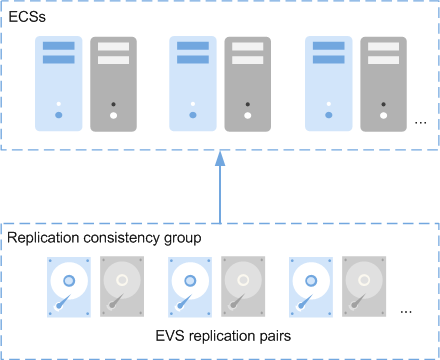Creating a Replication Consistency Group (Deprecated)¶
Scenarios¶
Currently, users need to make API calls to create replication consistency groups and add EVS replication pairs to the groups. For details, see Replication Consistency Group in the Elastic Volume Service API Reference.
A replication consistency group is composed of EVS replication pairs from a group of servers. These servers may run applications that are strongly correlated with each other and require unified management and application consistency. In this case, you can first create EVS replication pairs using the disks attached to these servers, then add these EVS replication pairs to a replication consistency group to facilitate management and consistency. Figure 1 shows the relationship between EVS replication pairs and replication consistency groups. If you have performed an operation to a replication consistency group, all EVS replication pairs in this group are affected.

Figure 1 Relationship between EVS replication pairs and replication consistency groups¶
Existing EVS replication pairs can be added to a replication consistency group upon the group creation. To add EVS replication pairs to or remove them from a replication consistency group after the group creation, see Updating a Replication Consistency Group (Deprecated).
Note
EVS replication APIs have been deprecated. If you need to use the replication function, see Storage Disaster Recovery Service User Guide and Storage Disaster Recovery Service API Reference.
Procedure¶
Create a replication consistency group and add all EVS replication pairs of a server to the group.
For details, see Creating a Replication Consistency Group in the Elastic Volume Service API Reference.
Query the details about the replication consistency group.
For details, see Querying Details About a Replication Consistency Group in the Elastic Volume Service API Reference.
When the consistency group status changes to available, the creation is successful.
Take note of the production server ID, DR server ID, replication consistency group ID, EVS replication pair IDs in the replication consistency group, and primary site of the replication consistency group, which is the AZ containing production disks.
Note
For details about how to obtain the production server ID and DR server ID, see Collecting ECS Information (Deprecated).
Synchronize the data of a replication consistency group, which means that the data of all EVS replication pairs within the group is synchronized.
For details, see Synchronizing a Replication Consistency Group in the Elastic Volume Service API Reference.
Query the data synchronization status of the replication consistency group.
For details, see Querying Details About a Replication Consistency Group in the Elastic Volume Service API Reference.
When the replication status of the replication consistency group changes to active, the data in all EVS replication pairs of this group has been synchronized.
Note
The time required for the initial data synchronization within a replication consistency group varies depending on the number of the EVS replication pairs in the group, EVS disk capacity, and actual data amount. Normally, the initial data synchronization takes a relative long period of time. Please wait patiently.